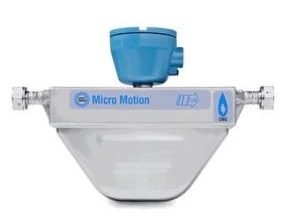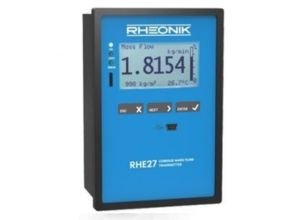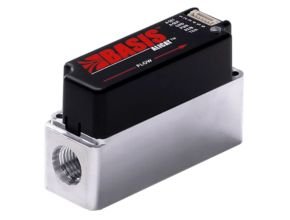Overview
The Emerson F025 Coriolis Flow Meter works similarly to the other Coriolis mass flow meter that is based on the principles of motion mechanics. When the process fluid enters the sensor, it is split.
During operation, a drive coil stimulates the tubes to oscillate in opposition at the natural resonant frequency. As the tubes oscillate, the voltage generated from each pickoff creates a sine wave. This indicates the motion of one tube relative to the other. The time delay between the two sine waves is called Delta-T, which is directly proportional to the mass flow rate.
A 316L Stainless Steel, high temperature Coriolis flow meter that delivers a highly reliable, repeatable, and robust measurement.
Features
- Achieve highly accurate mass volume flow and density measurement in applications that require a compact, drainable design
- Choose from 316L Stainless Steel and C-22 nickel alloy in all sizes
- Improve measurement and tracking with extensive process and meter diagnostics with on-board historian and logging
- A broad range of meter approvals and certifications, including; CSA (Class 1 Div 1 groups C and D, Class 1 Div 2 groups A, B, C, and D), ATEX, IECEx, Ingress Protection 66/67, and NAMUR
- Custody Transfer Approvals from MID-OIML R 117, National Type Evaluation Program (NTEP), Measurement Canada, and INMETRO Brazil
- Realize the fastest response rates and accurate batch and process measurement with unmatched MVD transmitter technology
- Gain real-time and in-process measurement integrity assurance with Smart Meter Verification
- Interact with our 3D model to learn more about our F-Series Coriolis Flow and Density Meters
High accuracy real-world performance
- Best-in-class performance on liquid mass flow, volume flow, and density measurements in a compact design
- Robust sensor design minimizes downtime and process interruption costs
Best fit-for-application
- Cleanable, self-draining design for critical process control service
- Compact design enables installation flexibility and reduced maintenance costs
Exceptional reliability and safety
- Global ISO/IEC 17025 calibration facilities deliver measurement confidence
As a practical application of the Coriolis effect, the Coriolis mass flow meter operating principle involves inducing a vibration of the flow tube through which the fluid passes. The vibration, though it is not completely circular, provides the rotating reference frame which gives rise to the Coriolis effect.
While specific methods vary according to the design of the flow meter, sensors monitor and analyze changes in frequency, phase shift, and amplitude of the vibrating flow tubes. The changes observed represent the mass flow rate and density of the fluid.
Reference operating conditions
For determining the performance capabilities of our meters, the following conditions were observed/utilized:
- Water at 68 to 77 °F and 14.5 to 29 psig (20 to 25 °C and 1 to 2 barg)
- Accuracy based on industry leading accredited calibration stands according to ISO/IEC 17025
- All models have a density range of up to 3 g/cm 3 (3000 kg/m 3 )
Specification
| Mass flow accuracy (Liquid) | ±0.20% of rate (standard)±0.15% of rate (optional)±0.10% of rate (optional) |
| Mass flow repeatability (Liquid) | ±0.050% of rate |
| Volume flow accuracy (Liquid) | ±0.28% of rate (standard)±0.25% of rate (optional)±0.15% of rate (optional) |
| Volume flow repeatability (Liquid) | ±0.050% of rate |
| Mass flow accuracy (Gas) | ±0.5% of rate |
| Mass flow repeatability (Gas) | ±0.25% of rate |
| Density accuracy (Liquid) | ±0.002 g/cm³ (2.0 kg/m³) (standard)±0.001 g/cm³ (1.0 kg/m³) (optional) |
| Temperature accuracy | ±1 °C ±0.5% of reading |
| Sensor maximum working pressure | 1,450 psig (100 barg) |
| Meter approvals, calibrations, and certifications | •UL |
| •CSA | |
| •IECEx | |
| •NEPSI | |
| •ATEX | |
| •Ingress Protection | |
| •EMC effects | |
| Output variables | Mass & volume flow |
| Temperature | |
| Density | |
| Pressure | |
| Concentration | |
| API average density | |
| Local display | Standard user interface with 2-line LCD panel |
| Two optical switches for local operation | |
| Two clips for service port connections (requires removing transmitter housing cover) | |
| Two clips for HART/Bell 202 connections (requires removing transmitter housing cover) | |
| HART security switch (requires removing transmitter housing cover) | |
| Glass lens | |
| Communication | Bell 202 |
| RS-485 | |
| Power | Self-switching AC/DC input, automatically recognizes supply voltage |
| 85 to 250 VAC, 48 to 62 Hz, 10 watts typical, 15 watts maximum | |
| 12 to 30 VDC, 7 watts typical, 14 watts maximum | |
| Complies with low voltage directive 2006/95/EC per EN 61010-1 (IEC 61010-1) with amendment 2 | |
| Input/output signals | Not intrinsically safe |
| Two active mA outputs, configurable to 4–20 mA or 0–20 mA | |
| One active/passive frequency/pulse output | |
| One active/passive discrete output | |
| One active discrete input | |
| One sensor frequency output | |
| One sensor temperature output | |
| One mA input |
ref: https://www.emerson.com/
Other Articles
- Small Size Coriolis Mass Flow Sensor RHM 04 Low Flow Mass Flow Meter flow rate
- Medium Size Coriolis Mass Flow Sensor RHM 20 Mass Flow Meter flow rate
- Large Size Coriolis Mass Flow Senso RHM 100 Coriolis Flow Mass Meter flow rate
- Flow Meter Open Channel Untuk PLTU
- Instalasi Flow meter ultrasonic clamp on untuk air dingin mesin chiller
- Prosedur Instalasi Flow Meter Electromagnetic
- Meteran air Jenis flow meter Ultrasonic
- Flow meter ultrasonic clamp on untuk pipa HDPE
- Penggunaan Flowmeter Ultrasonic Pada Pengolahan air limbah






